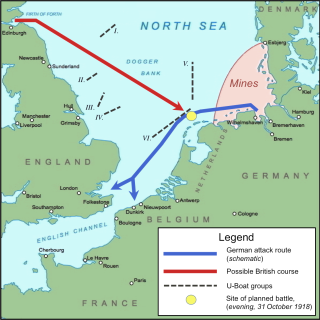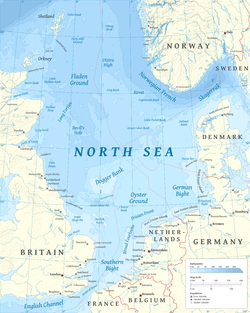
The Battle of Jutland was a naval battle fought between Britain's Royal Navy Grand Fleet, under Admiral Sir John Jellicoe, and the Imperial German Navy's High Seas Fleet, under Vice-Admiral Reinhard Scheer, during the First World War. The battle unfolded in extensive manoeuvring and three main engagements, from 31 May to 1 June 1916, off the North Sea coast of Denmark's Jutland Peninsula. It was the largest naval battle and the only full-scale clash of battleships of the war. Jutland was the third fleet action between steel battleships, following the Battle of the Yellow Sea in 1904 and the Battle of Tsushima in 1905, during the Russo-Japanese War. Jutland was the last major battle in history fought primarily by battleships.

The Battle of Heligoland Bight was the first Anglo-German naval battle of the First World War, fought on 28 August 1914, between ships of the United Kingdom and Germany. The battle took place in the south-eastern North Sea, when the British attacked German patrols off the north-west German coast. The German High Seas Fleet was in harbour on the north German coast while the British Grand Fleet was out in the northern North Sea. Both sides engaged in long-distance sorties with cruisers and battlecruisers, with close reconnaissance of the area of sea near the German coast—the Heligoland Bight—by destroyer.

The Battle of Dogger Bank was a naval engagement during the First World War that took place on 24 January 1915 near the Dogger Bank in the North Sea, between squadrons of the British Grand Fleet and the Kaiserliche Marine. The British had intercepted and decoded German wireless transmissions, gaining advance knowledge that a German raiding squadron was heading for the Dogger Bank and ships of the Grand Fleet sailed to intercept the raiders.

Carl Friedrich Heinrich Reinhard Scheer was an Admiral in the Imperial German Navy. Scheer joined the navy in 1879 as an officer cadet and progressed through the ranks, commanding cruisers and battleships, as well as senior staff positions on land. At the outbreak of World War I, Scheer was the commander of the II Battle Squadron of the High Seas Fleet. He then took command of the III Battle Squadron, which consisted of the newest and most powerful battleships in the navy. In January 1916, he was promoted to Admiral and given control of the High Seas Fleet. Scheer led the German fleet at the Battle of Jutland on 31 May – 1 June 1916, one of the largest naval battles in history.

HMS Iron Duke was a dreadnought battleship of the Royal Navy, the lead ship of her class, named in honour of Arthur Wellesley, 1st Duke of Wellington. She was built by Portsmouth Dockyard, and her keel laid in January 1912. Launched ten months later, she was commissioned into the Home Fleet in March 1914 as the fleet flagship. She was armed with a main battery of ten 13.5-inch (343 mm) guns and was capable of a top speed of 21.25 knots.

HMS Marlborough was an Iron Duke-class battleship of the Royal Navy, named in honour of John Churchill, 1st Duke of Marlborough. She was built at Devonport Royal Dockyard between January 1912 and June 1914, entering service just before the outbreak of the First World War. She was armed with a main battery of ten 13.5-inch (343 mm) guns and was capable of a top speed of 21.25 knots.

HMS Benbow was the third of four Iron Duke-class battleships of the Royal Navy, the third ship to be named in honour of Admiral John Benbow. Ordered in the 1911 building programme, the ship was laid down at the William Beardmore and Company shipyard in May 1912, was launched in November 1913, and was completed in October 1914, shortly after the outbreak of the First World War. The four Iron Dukes were very similar to the preceding King George V class, with an improved secondary battery. She was armed with a main battery of ten 13.5-inch (343 mm) guns and twelve 6 in (152 mm) secondary guns. The ship was capable of a top speed of 21.25 knots, and had a 12-inch (305 mm) thick armoured belt.

HMS Emperor of India was an Iron Duke-class battleship of the British Royal Navy. She was originally to have been named Delhi but was renamed before she was completed, to honour King George V, who was also Emperor of India at the time. The ship was laid down on 31 May 1912 at the Vickers shipyard, and was launched on 27 November 1913. The finished ship was commissioned a year later in November 1914, shortly after the start of the First World War. She was armed with a main battery of ten 13.5-inch (343 mm) guns and was capable of a top speed of 21.25 knots.

HMS Princess Royal was the second of two Lion-class battlecruisers built for the Royal Navy before the First World War. Designed in response to the Moltke-class battlecruisers of the Imperial German Navy, the ships significantly improved on the speed, armament, and armour of the preceding Indefatigable class. The ship was named after Louise, The Princess Royal, a title occasionally granted to the Monarch's eldest daughter.

HMS Lion was a battlecruiser built for the Royal Navy in the 1910s. She was the lead ship of her class, which were nicknamed the "Splendid Cats". They were significant improvements over their predecessors of the Indefatigable class in terms of speed, armament and armour. This was in response to the first German battlecruisers, the Moltke class, which were very much larger and more powerful than the first British battlecruisers, the Invincible class.

The Second Battle of Heligoland Bight, also the Action in the Helgoland Bight and the Zweite Seeschlacht bei Helgoland, was an inconclusive naval engagement fought between British and German squadrons on 17 November 1917 during the First World War.

The Raid on Scarborough, Hartlepool and Whitby on 16 December 1914 was an attack by the Imperial German Navy on the British ports of Scarborough, Hartlepool, West Hartlepool and Whitby. The bombardments caused hundreds of civilian casualties and resulted in public outrage in Britain against the German Navy for the raid and the Royal Navy for failing to prevent it.

HMS Nottingham was a Town-class light cruiser built for the Royal Navy just before World War I. She was one of three ships of the Birmingham sub-class and was completed in early 1914. The ship was assigned to the 1st Light Cruiser Squadron (LCS) of the Home and Grand Fleets for her entire career. Nottingham participated in most of the early fleet actions, including the battles of Heligoland Bight, Dogger Bank, and Jutland, helping to sink several German ships during the battles. The ship was sunk by the German submarine U-52 during the Action of 19 August 1916.

The Bombardment of Yarmouth and Lowestoft, often referred to as the Lowestoft Raid, was a naval battle fought during the First World War between the German Empire and the British Empire in the North Sea.

The Battle of Jutland took place in the North Sea between the German High Seas Fleet and British Grand Fleet on the afternoon and evening of 31 May 1916, continuing sporadically through the night into the early hours of 1 June. The battle was the only direct engagement between the two fleets throughout World War I. The war had already been waged for two years without any major sea battle, and many of the people present did not expect that this patrol would end differently. Lack of experience still accounted for a number of mistakes by the combatants. The battle has been described in a number of phases, the last of which is the subject of this article.

The Battle of Dogger Bank on 10 February 1916 was a naval engagement between the Kaiserliche Marine of the German Empire and the Royal Navy of the United Kingdom, during the First World War. Three German torpedo boat flotillas sortied into the North Sea and encountered the British 10th Sloop Flotilla near Dogger Bank. The German vessels eventually engaged the British vessels, after mistaking them for cruisers instead of minesweeping sloops. Knowing they were out-gunned, the British attempted to flee and in the chase, the sloop HMS Arabis was sunk, before the British squadron escaped. As the cruisers of the Harwich Force returned to port, the light cruiser HMS Arethusa struck a mine, ran aground and broke in two. Although the Germans were victorious, they inflated the victory by reporting that they had sunk two cruisers.

SMS Markgraf was the third dreadnought battleship of the four-ship König class. She served in the Imperial German Navy during World War I. The battleship was laid down in November 1911 and launched on 4 June 1913. She was formally commissioned into the Imperial Navy on 1 October 1914, just over two months after the outbreak of war in Europe. Markgraf was armed with ten 30.5-centimeter (12 in) guns in five twin turrets and could steam at a top speed of 21 knots. Markgraf was named in honor of the royal family of Baden. The name Markgraf is a rank of German nobility and is equivalent to the English Margrave, or Marquess.

SMS Grosser Kurfürst was the second dreadnought battleship of the four-ship König class. Grosser Kurfürst served in the Imperial German Navy during World War I. The battleship was laid down in October 1911 and launched on 5 May 1913. She was formally commissioned into the Imperial Navy on 30 July 1914, days before the outbreak of war between Germany and the United Kingdom. Her name means Great Elector, and refers to Frederick William I, the Prince-elector of Brandenburg. Grosser Kurfürst was armed with ten 30.5-centimeter (12 in) guns in five twin turrets and could steam at a top speed of 21 knots.

The High Seas Fleet (Hochseeflotte) was the battle fleet of the German Imperial Navy and saw action during the First World War. The formation was created in February 1907, when the Home Fleet (Heimatflotte) was renamed as the High Seas Fleet. Admiral Alfred von Tirpitz was the architect of the fleet; he envisioned a force powerful enough to challenge the Royal Navy's predominance. Kaiser Wilhelm II, the German Emperor, championed the fleet as the instrument by which he would seize overseas possessions and make Germany a global power. By concentrating a powerful battle fleet in the North Sea while the Royal Navy was required to disperse its forces around the British Empire, Tirpitz believed Germany could achieve a balance of force that could seriously damage British naval hegemony. This was the heart of Tirpitz's "Risk Theory", which held that Britain would not challenge Germany if the latter's fleet posed such a significant threat to its own.

The naval order of 24 October 1918 was a plan made by the German Admiralty at the end of World War I to provoke a decisive battle between the German High Seas Fleet and the British Grand Fleet in the southern North Sea. When the order to prepare for the sortie was issued on 29 October, mutiny broke out aboard the German ships. Despite the operation being cancelled, these in turn led to the more serious Kiel mutiny, which was the starting point of the November Revolution and the proclamation of the Weimar Republic.




















